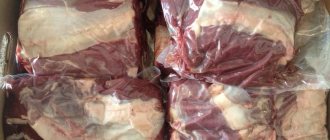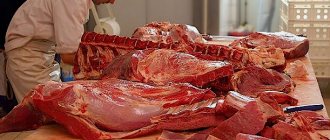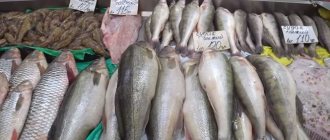Low-temperature warehouses can be used to store various products: fresh meat, fish, semi-finished products, etc. If the storage conditions of different categories of food products are observed, they can be stored for several months. The main task here is to ensure appropriate temperature conditions, humidity levels and comply with the rules of commercial proximity.
To store large volumes of products, you can use the rental service of a multi-temperature warehouse or enter into an agreement for responsible storage.
has a network of refrigerated warehouses in Moscow and the Moscow region. Call 8 (495) 646-77-77, we will select a suitable warehouse complex for your products.
Temperature conditions for storing different products
Freezing of different types of products requires compliance with certain conditions. If you follow the rules, products will retain their beneficial qualities for a long time, and after defrosting they will be as fresh as before freezing. Of course, the storage conditions for frozen products are determined by their characteristics. Our warehouses can store several types of goods:
Meat and poultry. Before freezing, meat must be cut into small pieces that are suitable for portion use: steaks, chops, minced meat, etc. Individual pieces should be separated from each other with cellophane or parchment to prevent freezing.
If poultry carcasses are frozen whole, they must be gutted. Otherwise, the warehouse will refuse to accept them. Pork and veal, as a rule, are frozen “paired”, but beef and lamb are best frozen 4-5 days after cutting.
Frozen meat and poultry are stored at temperatures from -18 to -24°C. The temperature regime is adjusted depending on the type of product. The shelf life of goose, duck, and rabbit meat is 6 months, pork and lamb are stored for the same amount of time, chicken and game are stored for 9 months, veal - 8, and beef can be stored frozen for up to 10 months.
Fish. Freezing fish within three hours after it was caught is considered optimal. Large fish, as a rule, must be pre-cut. Depending on the variety, fish can be stored for 2 to 6 months. Seafood (crayfish, crabs, shrimp, etc.) can be stored for no more than 3 months. The temperature range for storing these products is from -18 to -24° C.
Dairy . As a rule, perishable food products are stored for a short time in refrigerated warehouses and are immediately sent for sale. They can be stored at temperatures from 0 to 6°C. After the expiration date, the products are disposed of. Milk, cheeses, cottage cheese, etc. must be delivered to the consumer fresh, frozen, and defrosted before sale - it is impossible.
Vegetables, mushrooms . They are usually frozen in sliced form. However, only those vegetables that do not contain a large amount of water can be frozen (for example, it is better not to freeze cucumbers). Frozen vegetables are stored at temperatures down to -24°C.
Semi-finished products. Storage conditions depend on the type of product. Meat, fish, semi-finished dough or cottage cheese products require different storage conditions. Under no circumstances should they be placed together. Temperature conditions for long-term storage are up to -24°C.
How long can cooked meat be stored in the freezer?
The shelf life of cooked meat depends on the cooking method.
Roast
Fried pieces will last in the freezer for no more than 3 months, while their structure and properties quickly disappear due to the influence of vegetable oil. To maintain juiciness and freshness, use blast freezing after pre-cooling the product.
Boiled
If you cooked meat without spices or gravy, then it will retain its properties in the freezer for up to 10 months. If you used seasonings, they will be absorbed into the product and the taste will change. If the fillet is saltier and leaner, it will last longer.
Smoked
To preserve the flavor and texture of smoked meats, vacuum seal them or seal them in a container with a tight-fitting lid. The period during which the product will remain in the freezer without losing its freshness depends on the cooking method. Cold-smoked meat will retain its quality for 2 weeks, and hot-smoked meat for no more than 7 days.
Dried
This variety is the most resistant and can last in the freezer for up to 3 years. The only drawback is that after long-term freezing, the meat becomes dry and changes its smell.
How long can offal be stored in the freezer?
The shelf life of any offal in the freezer differs significantly from the shelf life of carcasses or fillets. For example:
- minced pork, beef or lamb will not lose quality for 4–5 months;
- minced chicken will last in the freezer for no more than 4 months;
- the liver, heart, lungs and other insides will not lose freshness in 3–4 months;
- sausage can remain in the freezer for no more than 2 months;
- It is unacceptable to keep boiled sausages, frankfurters and wieners in the freezer, since under the influence of low temperatures their structure completely changes.
How long can deep-frozen meat be stored?
Deep or shock freezing involves placing meat in a chamber with the lowest possible temperature. The fibers freeze very quickly, without having time to lose their quality properties. Such freezing increases the shelf life by almost 2 times. For example, beef can retain its taste for up to 24 months, and pork and chicken for up to 15.
Shelf life
The duration of food storage is determined by how accurately the standards for freezing were observed, and how the conditions in the warehouse were organized.
According to Russian food standards, the shelf life is the period during which the product retains its properties completely. After the shelf life has passed, the food is still edible, but its taste has deteriorated.
Another definition is shelf life. The shelf life is the period during which the product is suitable for consumption. After this period, the products cannot be eaten; they must be disposed of in accordance with the law.
The importance of freezing time
Food must be frozen quickly. This is due to the properties of water, which when frozen turns into ice crystals. The crystals expand. And since moisture is contained in any food product, slow crystallization of water leads to tissue rupture, and as a result, to the loss of microelements, vitamins and deterioration of taste.
The faster the product is frozen, the smaller the ice crystals. Accordingly, quick-frozen products retain much more beneficial properties, and their taste does not change after defrosting. In addition, rapid freezing contributes to the death of bacteria that may be on the surface of goods. That's why blast freezers are popular today. This is special equipment that allows you to freeze food as quickly as possible at extremely low temperatures.
Preparing for freezing
Food must be properly prepared before freezing. First, you need to make sure the quality of vegetables, fruits, meat, fish and other dishes. After all, cold can preserve the taste and nutritional properties of products, but it cannot improve their quality. Rotten potatoes will not stop being rotten after freezing.
Secondly, all products must be thoroughly washed, dried, and cleaned before being placed in the freezer. They should be ready to eat immediately after defrosting.
Thirdly, you should not put hot foods in the refrigerator. First you need to let them cool to room temperature.
Fourthly, you need to take care of the freezer. In order for freezing to be carried out quickly, you should prepare the compartment in advance: empty the zone of the lowest temperatures from the supplies lying in it. About 5 hours before placing new dishes in it, you should turn on the freezing mode. If the freezer does not have such a mode, then you should turn the temperature control knob to maximum cold. This will not only make freezing quick, but will also save already frozen food from unnecessary warming when adding a new portion of food.
Serving Size
Another important criterion that affects the time and quality of freezing is the size of the product. Industrial low-temperature warehouses allow freezing quite large volumes of products. However, the larger the portion size, the longer it will take to freeze it completely. Therefore, it is customary to freeze portioned pieces, which, when the temperature drops sharply, freeze evenly - from the edges to the center.
Freezing power also matters. Each freezer compartment is designed for a certain volume of products. You cannot put more goods in it, as this can significantly affect the quality of freezing. Also, you should not place products that require different freezing conditions in the same compartment.
Storage of frozen products
All frozen goods must be stored in special freezers. As a rule, refrigerated warehouse complexes are equipped with several such compartments to ensure the possibility of storing various types of products. All stored goods must be properly packaged and labeled. Keeping products in warehouses without labeling is not permitted. A label is placed on each product, indicating the date of freezing, repacking (if necessary), and expiration date. Compliance with storage conditions is monitored by the organization servicing the warehouse.
An important rule when placing products in a warehouse is compliance with the conditions of product proximity. This is a special set of rules that prescribes which goods cannot be placed together. For example, fresh meat, fish and processed foods cannot be stored next to each other. They are allowed to be kept in the same freezer only if they are packed in airtight containers.
If for some reason frozen food has thawed (equipment has broken down, power has gone out, etc.), under no circumstances should they be re-frozen. Such products are either urgently sent for sale, or, if it is impossible to sell, they are disposed of after the expiration date. Responsibility for violation of storage conditions, resulting in damage to products, lies with the organization that services the warehouse complex.
Rules for defrosting food
Even with proper freezing, the product may reach the point of being cooked in a less-than-standard condition. This happens if it was defrosted incorrectly. Most food products that have been frozen are sold frozen. Therefore, the task of defrosting falls on the shoulders of the consumer. The best option here is natural defrosting at room temperature. This takes on average several hours, but a lot depends on the portion size. You can also move the product into the refrigerator for slow defrosting.
Household appliances help speed up defrosting time. For example, microwave ovens equipped with a special defrosting mode make it possible to quickly and evenly defrost meat, fish or semi-finished products. Just don’t defrost meat and fish in hot water. Because of this, the products will lose a significant share of their nutrients and juices.
Most often, only confectionery products are defrosted in stores. In this case, the product must be marked with the date and time of defrosting. Products cannot be re-frozen. If the product was not sold before the expiration date, it must be removed from the shelf and sent for disposal.
Vegetables and mushrooms
It is best to freeze vegetables two to three hours after harvesting. They must be washed and, if necessary, cut into small pieces. You can blanch the vegetables in boiling water or simply dip them in boiling salted water for a few seconds (1 teaspoon of salt per 1 liter of water), cool under tap water, dry, portion out and put in the freezer.
You should not freeze vegetables with a lot of moisture (for example, cucumbers) and leaf salads. You can store frozen vegetables from six months to a year.
It is best to freeze mushrooms immediately after picking. They can be stored for six months.
"Multicold" - refrigerated warehouses in Moscow and the Moscow region
Our company provides storage services for products in multi-temperature warehouses. We have more than 185 thousand m² of warehouse space that can be rented for a long term. All warehouses are built in accordance with current standards, meet sanitary and hygienic requirements, and are equipped with modern refrigeration equipment. The complexes are under 24-hour security, and the performance of all systems is regularly monitored.
We work with food suppliers, trading companies, logistics centers, etc. Products are stored under proper conditions. For convenience, you can rent an office together with a warehouse directly on the territory of the agricultural hub.
To find out more about renting refrigerated, freezing warehouses or safekeeping services, please call.
Why is speed important when freezing?
Freezing food must be done very quickly. During slow freezing, large ice crystals will form from the water, which will begin to tear the tissues of the food. When the food is later thawed, juices will leak from the ruptures, which will lead to a decrease in nutritional value, deterioration in taste and appearance.
In addition, it is worth remembering that if there are any harmful bacteria on a product prepared for freezing, then they will not die in the freezer. At a temperature of -18 Celsius, their vital processes will slow down greatly, and the number of bacteria will not increase. But if the temperature rises (at least to -6 C), many bacteria will be able to multiply. Therefore, the higher the storage temperature, the more likely it is to get low-quality food over a long period of time that can harm your health.
Therefore, to avoid stomach problems, food should be frozen at a temperature of no more than -18C, and should be completely frozen inside, not just on top. The lower the temperature, the faster the food will freeze. Slow freezing or subsequent improper storage will lead to the possible growth of pathogenic bacteria. Eating improperly frozen food can cause significant harm to people's health.
Currently, the recommended freezing conditions are provided by refrigerators and freezers marked with four stars.
If you need high-quality storage of frozen food in large volumes, then you should rent freezer warehouses with low-temperature storage chambers. OJSC Moscow Cold Storage Plant No. 14 provides a full range of warehouse services. Refrigerated warehouses are available for rent for storing dairy products, sausages, and eggs. And if the volume of goods is small, then you can use the service of responsible food storage.









